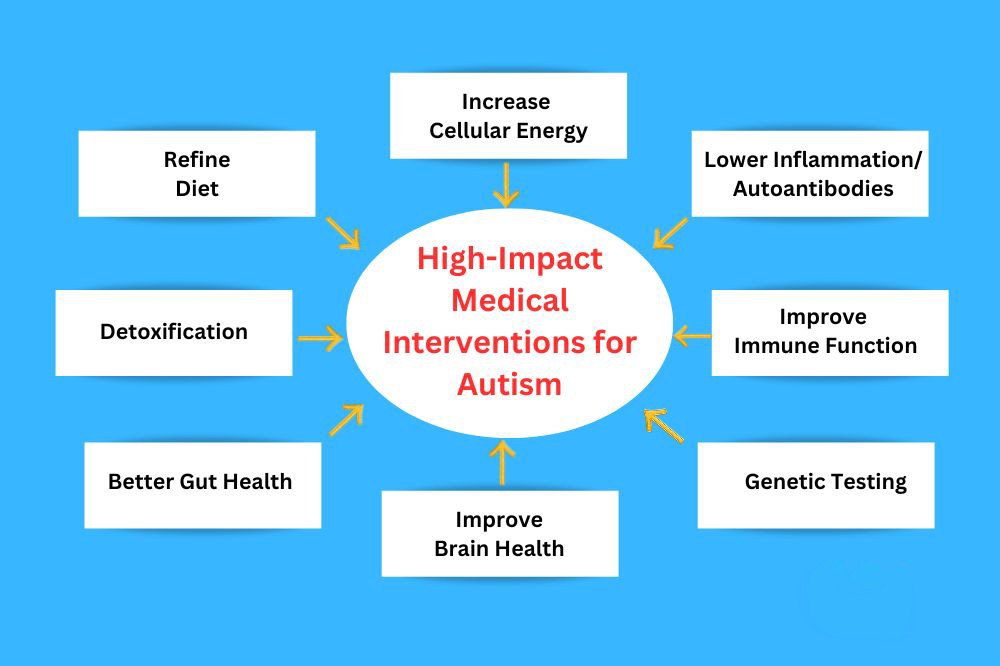Folic Acid and Pregnancy in the Prevention of Autism

All contents of this resource were created for informational purposes only and are not intended to be a substitute for professional advice, diagnosis, or treatment. Always seek the advice of your physician, therapist, or other qualified health providers with any questions or concerns you may have.

Richard Frye, MD, PhD
Autism, as we know, affects a significant proportion of our children, and the prevalence continues to rise. Unfortunately, neither the cause nor effective treatment is readily available. For many decades it has been assumed that autism is caused by a genetic abnormality, but despite decades of research it is becoming increasingly obvious that genetic abnormalities account for the cause of autism in the great minority of children. Indeed, a recent twin study demonstrates that the contribution of the environment and genetics to the development of autism is about 50/501. This is not the first time medicine has been faced with such a difficult type of disease to diagnose and treat. Indeed, the research findings on children with autism parallel some of the same biological mechanisms that find in cancer. When faced with such difficult disease to treat, medicine science has adopted the prevention approach. As we learn more about the risk factors associated with autism this is an approach we can adopt. Indeed, some leading clinicians have started to write about this approach2. Preventing autism from occurring would provide a great advance. Thus, the recent article in one of the leading medical journals provides exciting news.
In the article “Association Between Maternal Use of Folic Acid Supplements and Risk of Autism Spectrum Disorders in Children” published in Journal of the American Medical Association, researchers from Norway report a prospective study of 85,176 children3. These children and their mothers were followed from several weeks before pregnancy through childhood in order to determine the mother’s exposed to folic acid around the time of conception and whether the child developed one of the autism spectrum disorders (ASDs). Overall, 270 of the children developed an ASD (about 3 in 1000). The study found that the risk of developing autistic disorder, but not Asperger syndrome or pervasive developmental disorder—not otherwise specified, was lower in mothers that took folic acid supplements from 4 weeks before to 8 weeks after the start of pregnancy.
Although this is exciting news, the folate story is very complicated. Other studies in the United States have also demonstrated that folic acid around conception reduces the risk of autism4, but other studies from the United States have demonstrated that folic acid supplementation during pregnancy may be a risk factor for developing autism5. How can this be? In order to understand the completing, and seemingly contradictory results, we need to look deeper.
We must step back and consider the Norway study and its findings. This study was conducted in Norway where prevalence of ASD is much lower than the United States. In this study ASD was diagnosed in about 3 in 1000 children (0.3%) whereas the most recent estimates in the United States is that ASD affects 1 in 88 children (1.1%) – about 3.5 times more children. This suggests that the causes of ASDs may be different in the United States as compared to Norway, suggesting that the same therapeutic preventive strategies may not be completely equal in different countries because different biological mechanisms may be the main driver of ASD in various countries. The authors also admit several confounding factors that could not be controlled for in their study. For example, women who were more likely to supplement with folic acid around the time of conception were also of higher socioeconomic status and more likely to be health conscious, raising the possibility that other factors that were not measured during pregnancy and childhood could have reduced the risk rather than folic acid supplementation. In addition, the women in this study were generally healthy, had a low rate of medication use during pregnancy and were more likely to be first time mothers – all factors that reduce the risk of a child developing autism in general. However, the authors note that the protective effect found for folic acid was not found for fish oil supplementation despite the fact that these maternal characteristics were similar for women who used fish oil supplementation.
One limitation that the authors did not mention in their manuscript is the difference in the fortification of food with folic acid in Norway as compared to other countries like the United States. Because folic acid has been found to prevent neural tube defects, approximately two decades ago, folic acid supplementation was officially recommended in the United States for all women of child bearing age. Furthermore, all grains sold in the United States were required to be fortified with folic acid. Such steps have drastically reduced the number of neural tube related birth defects. In contrast, Norway does not require such folate supplementation for women of child bearing age or fortification of foods. Thus, in the context of the difference in the public policy of folic acid supplementation and fortification between the two countries, the significance of this research for preventing autism in the United States may be somewhat underwhelming.
The other important, underappreciated subtle aspect to folic acid supplementation is the fact that the widely used supplementation and fortification form of folate, folic acid, is a synthetic oxidized form of folate. This is mostly due to the fact that this form of folate is inexpensive, thus allowing widespread fortification of foods practical. The oxidized form of folate needs to be converted into a reduced form by dihydrofolate reductase in order to be optimally used by metabolic systems of the body. Detrimental genetic changes in this enzyme have been found to be associated with autism6. With such changes in enzyme activity could result in the build-up of the oxidized form of folate and a reduction in the reduced form of folate. In such a case, it may be advantageous use a reduce form of folate such as 5-methyltetrahydrofolate or folinic acid.
Additionally, an autoantibody to the folate receptor alpha has been discovered within the last decade. This autoantibody reduces folic acid from being transported into specific organs, including the brain, thyroid and placenta7. These antibodies have been linked to neurodevelopmental disabilities, including autism, in children7 and neural tube defects8 and subfertility9 when found in women. In children with ASD and these autoantibodies, supplementation with a reduced form of folate, specifically folinic acid, appears to be beneficial in preliminary studies7. It is not clear how these autoantibodies development. Folate receptor autoantibodies are known to cross-react with folate receptors in human, bovine and goat milk suggesting that exposure to any of these milk products could result in development of these autoantibodies10. However, it is also very possible that high levels of synthetic folic acid as could occur with excessive supplementation or when folic acid is not converted to its reduced form due to detrimental genetic variants could also result in the production of autoantibodies. In either case, the existence of autoantibodies may block folate transport into several organs of the body regardless of how much supplemental folic acid is given.
Furthermore, genetic variation in the reduced folate carrier, another mechanisms that transports folates, specifically reduced folates, into organs, have been linked to autism when present in either the child11 or the mother12. Again, the fact that genetic changes in the mother can affect the outcome of the child exemplifies the importance of folate metabolism during pregnancy. The fact that this folate carrier is specific for reduced folates again exemplifies the importance of reduced folates in fetal development. Of note, the reduced folate carrier is a particularly important mechanism for transporting folate into organs when the folate receptor alpha autoantibody blocks the transport mechanism for folic acid.
Recently DeSoto and Hitlan5 used the Centers for Disease Control Vaccine Safety Datalink public use data set to examine the relationship between the development of ASDs and the use of folic acid during pregnancy. The found that ASD and autistic disorder were both associated with mothers reporting taking folate supplementation during pregnancy. They also found that both ASD and autistic disorder was associated with living below the poverty line, among other factors. In contrast to the study from Norway which was prospective, the information about folate supplementation during pregnancy in the Desoto and Hitlan study was obtained through a retrospective report and didn’t distinguish folic acid supplementation during conception from folic acid supplementation during the entire pregnancy. Furthermore, the database used by Desoto and Hitlan probably better represented lower social economic class as compared to the Norway study.
So what does this all mean for reducing the risk of having an autistic child in the United States? Both the Norway study3 and the recent study from University of California at Davis11 suggest that standard folate supplementation around the time of conception is important for preventing the development of autism. This is not especially a surprise as folate is essential for the growth, reproduction and stability of cells and is essential for ensuring that genes are copied without errors. These are all essential for the growing fetus, especially early in pregnancy when the organs are forming. In general, women in the United States are recommended to take prenatal vitamins if they expect to become pregnant and during pregnancy. In addition, many foods, especially grains, are fortified with folic acid in the United States. Thus, the findings from these studies should not be particularly applicable to women who follow the advice of their doctors and have good nutrition. Such women already have reduced their risk.
The fact that we are still looking at these simple factors that we know are important for pregnancy is great. However, the fact that so many abnormalities of the folate pathway are associated with autism and that these factors may affect the fetus and child beyond the short period during conception should be a wake-up call that medical research has to move outside of its comfort zone and look at new and more complicated factors related to folate metabolism that could related to the development of autism. Indeed, we have found several genetic and autoimmune markers that are related to the development of autism but we still do not understand how these factors interact with each other and other metabolic, genetic and environmental factors to lead to the development of autism. Most importantly, treatment studies leading to preventive strategies are only beginning to be discussed. The Norway study is important, but is only the very beginning; given the continued rise in the prevalence of autism, treatment studies are emergently needed to help our children.
References
- Hallmayer J, Cleveland S, Torres A, Phillips J, Cohen B, Torigoe T, Miller J, Fedele A, Collins J, Smith K, Lotspeich L, Croen LA, Ozonoff S, Lajonchere C, Grether JK, Risch N. Genetic heritability and shared environmental factors among twin pairs with autism. Archives of general psychiatry. 2011;68(11):1095-1102.
- Berger D. From preconception to infancy: environmental and nutritional strategies for lowering the risk of autism. Autism Science Digest. 2012;1(4):17-25.
- Suren P, Roth C, Bresnahan M, Haugen M, Hornig M, Hirtz D, Lie KK, Lipkin WI, Magnus P, Reichborn-Kjennerud T, Schjolberg S, Davey Smith G, Oyen AS, Susser E, Stoltenberg C. Association between maternal use of folic acid supplements and risk of autism spectrum disorders in children. JAMA . 2013;309(6):570-577. PMCID:
- Schmidt RJ, Tancredi DJ, Ozonoff S, Hansen RL, Hartiala J, Allayee H, Schmidt LC, Tassone F, Hertz-Picciotto I. Maternal periconceptional folic acid intake and risk of autism spectrum disorders and developmental delay in the CHARGE (CHildhood Autism Risks from Genetics and Environment) case-control study. The American journal of clinical nutrition. 2012;96(1):80-89.
- DeSoto C, Hitlan RT. Synthetic folic acid supplementation during pregnancy may increase the risk of developing autism. J Ped Biochem. 2012;2(4):251-261.
- Adams M, Lucock M, Stuart J, Fardell S, Baker K, Ng X. Preliminary evidence for involvement of the folate gene polymorphism 19bp deletion-DHFR in occurrence of autism. Neuroscience letters. 2007;422(1):24-29.
- Frye RE, Sequeira JM, Quadros EV, James SJ, Rossignol DA. Cerebral folate receptor autoantibodies in autism spectrum disorder. Molecular psychiatry. 2012, in press.
- Molloy AM, Quadros EV, Sequeira JM, Troendle JF, Scott JM, Kirke PN, Mills JL. Lack of association between folate-receptor autoantibodies and neural-tube defects. N Engl J Med. 2009; 361(2):152-160.
- Berrocal-Zaragoza MI, Fernandez-Ballart JD, Murphy MM, Cavalle-Busquets P, Sequeira JM, Quadros EV. Association between blocking folate receptor autoantibodies and subfertility. Fertil Steril. 2009;91(4 Suppl):1518-1521.
- Ramaekers VT, Sequeira JM, Blau N, Quadros EV. A milk-free diet downregulates folate receptor autoimmunity in cerebral folate deficiency syndrome. Dev Med Child Neurol. 2008; 50(5):346-352.
- James SJ, Melnyk S, Jernigan S, Cleves MA, Halsted CH, Wong DH, Cutler P, Bock K, Boris M, Bradstreet JJ, Baker SM, Gaylor DW. Metabolic endophenotype and related genotypes are associated with oxidative stress in children with autism. American journal of medical genetics. Part B, Neuropsychiatric genetics. 2006;141B(8):947-956.
- James SJ, Melnyk S, Jernigan S, Pavliv O, Trusty T, Lehman S, Seidel L, Gaylor DW, Cleves MA. A functional polymorphism in the reduced folate carrier gene and DNA hypomethylation in mothers of children with autism. American journal of medical genetics. Part B, Neuropsychiatric genetics. 2010;153B(6):1209-1220.




